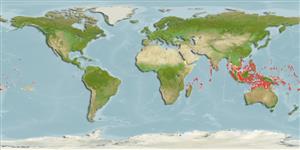Common names from other countries
>
Anguilliformes (Eels and morays) >
Muraenidae (Moray eels) > Muraeninae
Etymology: Gymnothorax: Greek, gymnos = naked + Greek, thorax, -akos = breast (Ref. 45335).
More on author: Seale.
Environment: milieu / climate zone / depth range / distribution range
экология
морской ассоциированный с рифами; пределы глубины 1 - 40 m (Ref. 30874), usually 20 - 40 m (Ref. 9710). Tropical; 19°N - 18°S
Indo-Pacific: East Africa to the Marquesan and Society islands, north to the Philippines.
Size / Вес / Возраст
Maturity: Lm ? range ? - ? cm
Max length : 50.0 cm TL самец/пол неопределен; (Ref. 48635); common length : 30.0 cm TL самец/пол неопределен; (Ref. 30404)
колючие лучи спинного плавника (общее число) : 0; членистые (мягкие) лучи спинного плавника (общее число) : 0; колючие лучи анального плавника: 0; членистые (мягкие) лучи анального плавника: 0; позвонки: 122 - 130. Color brown with about 4 longitudinal rows of dendritic black blotches; very fine white scribbling anteriorly on body and fins; behind eye an irregular black spot bordered above and below by white; pores on side of jaws in large white spots. Juveniles distinctly marked on the head and adults plain brown, but showing black barring posteriorly on the dorsal and anal fins on the tail (Ref. 48635).
Occurs in ledges and rubble areas of outer reef slopes to depths of at least 40 m. Feeds on small fishes and crustaceans (Ref. 89972). Usually in caves below 20 m (Ref. 9710, 58302). Secretive in reefs during the day, usually only seen at night (Ref. 48635). Benthic (Ref. 58302). Minimum depth reported taken from Ref. 86942.
Life cycle and mating behavior
Maturities | размножение | Spawnings | Egg(s) | Fecundities | личинки
Chen, H.-M., K.-T. Shao and C.T. Chen, 1994. A review of the muraenid eels (Family Muraenidae) from Taiwan with descriptions of twelve new records. Zool. Stud. 33(1):44-64. (Ref. 6934)
Статус Красного Списка МСОП (Ref. 130435)
CITES (Ref. 128078)
Not Evaluated
Угроза для людей
Harmless
Использование человеком
рыболовство: не имеет хозяйственного значения
дополнительная информация
инструменты
Специальные отчеты
Скачать в формате XML
ресурсы в Интернет
Estimates based on models
Preferred temperature (Ref.
115969): 26.1 - 28.9, mean 28 (based on 294 cells).
Phylogenetic diversity index (Ref.
82804): PD
50 = 0.5000 [Uniqueness, from 0.5 = low to 2.0 = high].
Bayesian length-weight: a=0.00056 (0.00037 - 0.00084), b=3.21 (3.09 - 3.33), in cm Total Length, based on LWR estimates for this species & Genus-body shape (Ref.
93245).
Trophic level (Ref.
69278): 3.9 ±0.6 se; based on size and trophs of closest relatives
устойчивость к внешним воздействиям (Ref.
120179): средний (среднего размера), минимальное время удвоения популяции 1.4-4.4 года (Preliminary K or Fecundity.).
Fishing Vulnerability (Ref.
59153): Moderate vulnerability (40 of 100).
